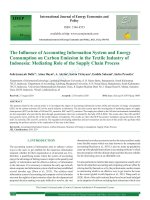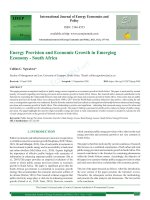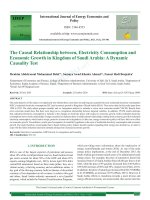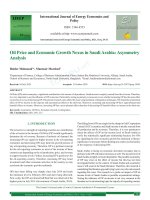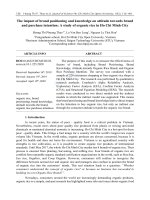Energy provision and economic growth in emerging economy - South Africa - TRƯỜNG CÁN BỘ QUẢN LÝ GIÁO DỤC THÀNH PHỐ HỒ CHÍ MINH
Bạn đang xem bản rút gọn của tài liệu. Xem và tải ngay bản đầy đủ của tài liệu tại đây (357.98 KB, 5 trang )
<span class='text_page_counter'>(1)</span><div class='page_container' data-page=1>
<b>International Journal of Energy Economics and </b>
<b>Policy</b>
ISSN: 2146-4553
available at http: www.econjournals.com
<b>International Journal of Energy Economics and Policy, 2021, 11(1), 137-141.</b>
<b>Energy Provision and Economic Growth in Emerging </b>
<b>Economy - South Africa</b>
<b>Collins C. Ngwakwe*</b>
Faculty of Management and Law, University of Limpopo, South Africa. *Email:
<b>Received:</b> 19 April 2020 <b>Accepted:</b> 15 September 2020 <b>DOI:</b> />
<b>ABSTRACT</b>
This paper presents an empirical analysis of public energy access imperative on economic growth in South Africa. The paper is motivated by current
paucity of research regarding rural energy provision and economic growth in South Africa. Hence, this research adds a nuanced contribution to the
literature by examining the relationship between rural and urban energy provision and economic growth in South Africa. Time series data on public
electricity provision for South Africa were collected from 1998 to 2017 from the World Bank economic indicators’ data archive. After testing for unit
root, a cointegration regression was conducted. Results from the statistical analysis indicate a cointegration relationship between urban and rural energy
provision and economic growth in South Africa. This relationship is positive and significant – indicating that increased energy access for urban and
rural dwellers is a veritable tool for stimulating economic growth. The paper’s finding is germane for public policy makers in charge of public energy
provision. The paper highlights the need for improved public energy provision to rural communities. Further research is needed to examine the role
of rural energy provision on the growth of informal economy in South Africa.
<b>Keywords:</b> Public Energy Provision, Economic Growth, Urban Energy Access, Rural Energy Access, South Africa, Energy Provision
<b>JEL Classifications:</b> O1, O2, H4
<b>1. INTRODUCTION</b>
Public investments and infrastructure provision are recognized as
a veritable avenue for economic growth (Hauptman, 2018; Yilmaz,
2018; Ott and Mihaljek, 2018). One of such public investments is
the investment in public energy and its accessibility to both rural
and urban dwellers (McCollum et al., 2018). Experts highlight
the importance of effective public budgets with symmetry of
information in enhancing important public investments (Ott et
al., 2019).This paper provides an empirical evaluation of the
extent to which public energy provision relates to economic
growth in South Africa. The paper is significant given that the
South African government is committed to economic growth
strategy that accommodates the economic and social welfare of
its citizens (Horner, 2016). Prior research evidence suggests that
public electricity usage plays a vital role in enhancing economic
growth (Ozturk et al., 2010; Tsani, 2010). However, research
which examines public energy provision with a slant on the rural
energy provision and economic growth is not very common in
South Africa.
The paper is therefore motivated by current scantiness of research
that focuses on a combined examination of both urban and rural
public energy provision and economic growth in South Africa. This
research contributes to the literature by examining phenomenon
within the South African context. Accordingly, the objective of
this paper is to examine whether public energy provision to urban
and rural areas does have a relationship with economic growth.
The rest of the paper proceeds as follows. After this introduction,
the next section if the paper presents the literature review.
Thereafter, the subsequent section discusses the methodology
and presents the data analysis and discussions. The last section
is the conclusion.
</div>
<span class='text_page_counter'>(2)</span><div class='page_container' data-page=2>
<b>2. LITERATURE REVIEW </b>
Ozturk et al. (2010) applied a panel data of energy usage compared
with gross domestic product as a proxy for economic growth
for fifty one countries. They classified the countries into three
categories of income namely low, middle and upper income
countries. Applying the Pedroni cointegration approach of panel
data; they find that in all the income grouping of countries,
energy usage has a cointegration with economic growth variable.
Furthermore, using the panel data causality analysis, the results
show a long run causality, which is unidirectional from the GDP
to energy usage on the lower income countries, the same result
for middle income countries show a bidirectional relationship.
However, they found given that the cointegration result for B
is <1, they conclude that the relationship between energy usage
and economic growth is weak. In a closely related research, Tsani
(2010) examine the causality relationship between energy usage
and economic growth in Greece. He applied a different method
by examining energy consumption at two aggregate levels namely
disaggregated and aggregated levels of energy usage. For the
aggregated level of energy usage, the empirical finding indicates a
unidirectional relationship from energy usage to economic growth
(represented by real GDP), however at the disaggregated level,
the result indicates a bidirectional causal relationship between
industrial and household energy usage and economic growth
(Tsani, 2010).
Taking a different look at energy usage, other researchers have
instead analysed energy usage and economic growth using a per
capita approach; for example, per capital usage of energy was
analysed against per capita gross domestic product to see how
the two variables cointegrate and their likely causality using data
from Tunisia (Belloumi, 2009). Using a Vector Error Correction
Model of Granger Causality and cointegration, their analysis found
that the two variables have a cointegration of one vector and also
found a long-run bidirectional causal relationship between per
capita energy usage and per capita gross domestic product; they
highlight that the factor causing the long run relationship is the
error correction term in the two variables. However, they find
that in short run, there is a unidirectional causality from energy
to economic growth (Belloumi, 2009).
A different dimension of study by Tugcu and Topcu (2018)
divide energy into three categories, namely total energy usage,
renewable energy usage and non-renewable energy usage in the
G7 industrialised nations by applying the nonlinear approach
of autoregressive lag combined with the asymmetric genre of
causality techniques. They find that the usage of total energy
proves to be asymmetrically related to economic growth in
the long run, but application of other categorizations produce
volatile results. In another similar research, the effect of
renewable and non-renewable energy usage was evaluated using
a panel data from 29 OECD countries (Gozgor et al., 2018).
They applied the statistical technique of panel autoregressive
distribution lag (ARDL) followed by a triangulation with the
panel quantile regression (PQR) analysis. The results showed a
positive relationship between renewable, non-renewable energy
consumption and economic growth in the OECD countries
(Gozgor et al., 2018). The volatile results reported in Tugcu and
Topcu (2018) was not found in Gozgor et al. (2018) possibly due
to slight methodological difference in asymmetric and symmetric
causality techniques applied in Tugcu and Topcu (2018). However
the two results are similar in terms of the relationship with total
energy usage. In their research, Adams et al. (2018) examined
how two energy types namely renewable and non-renewable
energy affect economic growth; they also add the mediating effect
of regime type in their model in order to determine the effect of
regime type on economic growth jointly with renewable and
non-renewable energy effects. They applied the cointegration statistics
and error correction model to analyse the heterogeneous panel
data. Their results found a long run positive relationship between
the variables. However, they note that non-renewable energy has a
greater positive effect on economic growth than renewable energy.
This is because, they found that a 10% increase in non-renewable
energy leads to a 2.11% increase in economic growth, but the same
10% increase in renewable energy only leads to a 0.27 increase
in economic growth(Adams et al., 2018). This brings attention
to an important energy consumption strand, which is that
non-renewable energy seems to be more closer to the greater majority
of citizens chiefly because of the cost involvement in renewable
energy (Karekezi, 2002).
Kebede et al. (2010) evaluated the link between energy usage
and economic growth in 20 Sub-Saharan Africa using a
cross-sectional time series data of 25 years. They divided energy into
wood fuel usage, petroleum demand and electricity usage. Results
from regression analysis show that energy usage is positively
related to GDP growth and agricultural growth. Furthermore, they
found an inverse relationship between petroleum price, demand
for petroleum and industrial growth. They also highlight that
differences in regional GDP growth is related to differences in
energy usage; this attests to the importance of energy availability
and usage on economic growth. In conclusion Kebede et al. (2010)
emphasize the need to diversify sources of energy to carter for
different sectorial energy needs. Richard (2012) examined the
asymmetric relationship between energy consumption per capita
and economic growth represented by real GDP per capita in
twelve Sub-Saharan Africa for the period of 1971-2008 using a
hidden cointegration technique. Their results show that policies
on energy conservation can have adverse effect on economic
growth in Sub-Saharan African countries. Mohammed et al.
(2013) provides a supportive review findings that low level of
electricity access contributes significantly to slow development
in Sub-Saharan Africa. Ouédraogo (2010) examined the causal
direction between electricity usage and economic growth in
Burkina Faso for the years 1968-2003. Results from cointegration
and causality tests show that electricity consumption in Burkina
Faso has a significant causal relationship with economic growth
and capital formation, which enhances improved investment.
They also found an existence of bidirectional causality between
electricity consumption and real GDP.
</div>
<span class='text_page_counter'>(3)</span><div class='page_container' data-page=3>
panel-vector autoregression and causality analysis data from South
and South-East Asian countries indicates a bidirectional causal
relationship for energy usage and economic growth (Rezitis and
Ahammad, 2015).
The foregoing indicates the importance of energy in economic
development. The following section evaluates the data relating to
South Africa, which focusses uniquely on public energy provision
and economic growth.
<b>3. METHOD AND FINDINGS</b>
In an attempt to determine whether a relationship exists between
electricity provision and economic growth in South Africa,
the research mimicked previous researchers’ application of a
quantitative approach. A time series data for 1998-2017 were
collected from the World Bank archives of economic indicators
(gross domestic product and electricity access) for South Africa
(World Bank, 2019). The Granger co-integration approach was
used to determine the relationship between the independent
variables (urban and rural energy access) and the dependent
variable (economic growth) after testing for the likelihood of
unit root existence. According to experts’ recommendation, the
usage of a time series requires non-existence of unit root and/
or the existence of stationary data (Duke University, 2019). The
application of cointegartion analysis is common in previous
studies regarding energy and economic growth (Ozturk et al.,
2010; Binh, 2011; Phrakhruopatnontakitti and Jermsittiparsert,
2020; Tang et al., 2016). This paper adds to these previous papers
by focusing on an emerging economy South Africa and does this
by looking at energy access in two different areas – the rural area
energy access and the urban area energy access, this demarcation
is not very common in the previous research and therefore adds a
methodological nuance to existing research.
Regression Model
Y = β<sub>0</sub> + β<sub>1</sub>X<sub>1</sub> + β<sub>2</sub>X<sub>2</sub> + e
Where: Y = Economic growth (GDP); X<sub>1 = </sub>Urban electricity access;
X<sub>2 </sub>= Rural electricity access
β<sub>0</sub> = Intercept; β<sub>1</sub>−β<sub>2</sub> = Regression coefficients; e = Error term.
<b>3.1. Results</b>
In compliance with the recommendation by Duke University
(2019), before proceeding to the analysis of possible
co-integration, the paper tested for the existence of unit roots or
non-stationarity, which gives the impetus to progress to the
co-integration regression. From the results in Tables 1-3, it can be
seen that the time series variables have no unit root, this is because
the null hypothesis for the Dickey-Fuller test unit root test is
stated as a = 1 (which is that unit root exists) or that the variable
is non-stationary. The associated P-values for unit root in GDP
(the dependent variable) shows a P < 0.04, which is lower than
the research alpha of 0.05. Therefore, the null hypothesis for unit
root in GDP is rejected to show that the GDP variable in this paper
has no unit root and is stationary.
Similarly, the test for unit roots in the independent variables (urban
access and rural access to electricity) show a P-value of 0.19 and
0.15 for urban access and rural access respectively. Since these
P-values for the independent variables are both lower than the
alpha value of 0.05; the unit root null hypothesis for urban and
rural access to electricity, which indicates existence of unit root
are rejected to show that there is no unit root in the urban and
rural access to electricity variables and hence these independent
variables are stationary. Additionally, the unit-root null hypothesis
for residuals or (uhat) (Table 4) is also rejected, which shows that
the residuals or (uhat) are stationary.
Therefore, the stationarity of the time series variables provided
impetus to test for a relationship between electricity access and
economic growth using the cointegration relationship. From the
results in Table 5, it can be seen that the t-ratio for urban public
energy is 2.577 with a P-value of 0.0196, which is less than 0.05
alpha value. In the same vein, the t-ratio for rural public energy
is 2.440 with a P-value of 0.0259. This therefore signifies that a
cointegration relationship exists between electricity access and
economic growth (GDP). A finding that is worth noting from this
is that, although both independent variables show a relationship,
but a closer look at the urban electricity access variable indicates
it has a stronger P-value (0.01) better than the rural electricity
<b>Table 1: Testing for a unit root in GDP</b>
Augmented Dickey-Fuller test for GDP
Including one lag of (1−L)GDP
Sample size 18
Unit-root null hypothesis: a=1
Test with constant
Model: (1−L)y = b0 + (a−1)*y(−1) + ... + e
1st<sub>-order autocorrelation coeff. for e: 0.136</sub>
Estimated value of (a−1): −0.146061
Test statistic: tau_c(1)=−1.64863
Asymptotic P-value 0.04576
<b>Table 3: Testing for a unit root in RAccElect</b>
Augmented Dickey-Fuller test for RAccElect
Including one lag of (1−L)RAccElect
Sample size 18
Unit-root null hypothesis: a=1
test with constant
Model: (1−L)y = b0 + (a−1)*y(−1) + ... + e
1st<sub>-order autocorrelation coeff. for e: −0.008</sub>
Estimated value of (a−1): −0.295232
Test statistic: tau_c(1) = −2.35072
Asymptotic P-value 0.01561
<b>Table 2: Testing for a unit root in UAccElect</b>
Augmented Dickey-Fuller test for UAccElect
Including one lag of (1−L)UAccElect
Sample size 18
Unit-root null hypothesis: a=1
Test with constant
Model: (1−L)y = b0 + (a−1)*y(−1) + ... + e
1st<sub>-order autocorrelation coeff. for e: −0.080</sub>
Estimated value of (a−1): −0.02362
Test statistic: tau_c(1) = −0.387116
</div>
<span class='text_page_counter'>(4)</span><div class='page_container' data-page=4>
access with a P-value of 0.02. This implies that urban electricity
access has a higher propensity to influence economic growth in an
emerging economy South Africa. This is visible in the regression
co-efficient, which shows that a unit increase in urban access
to electricity will result to a 288.3 unit increase in economic
growth (GDP) and that a unit increase in rural electricity access
will result to a 76.2 unit increase in economic growth (GDP). In
Table 5, the Durbin Watson statistics of 2.01 indicates absence of
autocorrelations and the R-squared of 72% shows a fairly good
fit between the independent variables and the dependent variable
in the regression line. This fit accentuates the low p-values which
indicate that electricity access does influence economic growth in
South Africa. In Table 5, the model selection parameters namely
the Schwarz criterion, the Hannan-Quinn and the Akaike criterion
are all in the range of 300; further research that may use South
African data should therefore compare these values against the
values obtained by using another method of analysis and be able to
selected the best model based on the method that offers the lowest
of Schwarz criterion, the Hannan-Quinn and the Akaike criterion.
The finding from this research is consistent with the findings of
similar research that were conducted in other countries, which
found a relationship between energy access and economic
growth (Ozturk et al., 2010; Ozturk, 2010; Mohammed et al.,
2013; Gozgor et al., 2018; Kebede et al., 2010). However, the
uniqueness of this present research finding is its concentration on
one emerging economy – South Africa and with a unique result
that emerged from the demarcation between rural energy access
and urban energy access, which suggests that urban energy is more
influential on the GDP than rural energy access. This finding calls
for more study using other emerging countries.
<b>4. CONCLUSION </b>
The relationship between energy usage and economic growth has
been widely studied in other countries. This paper contributes in
a unique way by studying the relationship between government
provision of energy to rural and urban dwellers and economic
growth in South Africa. A cointegration regression was used to
analyse the data collected from 1998 to 2017. Results from the
analysis showed a positive and significant relationship between
public energy provision to both urban and rural dwellers and
economic growth in South Africa. This implies that, much as urban
energy provision is important, rural energy provision is also vitally
important for economic growth as this carters for rural dwellers
who need energy to engage in small scale business activities.
The paper’s finding is germane for public policy makers in charge
of energy provision. The paper recommends the need for an
enhanced energy policy, which supports an improved public energy
access to rural communities in South Africa. Further research is
recommended to examine the role of rural energy provision on
the growth of informal economy in South Africa and toward the
achievement of Agenda 2030 poverty reduction goal.
<b>REFERENCES</b>
Adams, S., Klobodu, E.K.M., Apio, A. (2018), Renewable and
non-renewable energy, regime type and economic growth. Renewable
Energy, 125, 755-767.
Belloumi, M. (2009), Energy consumption and GDP in Tunisia:
Cointegration and causality analysis. Energy Policy, 37(7),
2745-2753.
Binh, P.T. (2011)., Energy consumption and economic growth in Vietnam:
Threshold cointegration and causality analysis. International Journal
of Energy Economics and Policy, 1(1), 1-17.
Duke University. (2019), Stationarity and Differencing. Available from:
/>
Gozgor, G., Lau, C.K.M., Lu, Z. (2018), Energy consumption and
economic growth: New evidence from the OECD countries. Energy,
153, 27-34.
Hauptman, M. (2018), Importance of public investment for economic
growth in the European Union. Public Sector Economics, 42(2),
131-137.
Horner, R. (2016), A new economic geography of trade and development?
Governing South-South trade, value chains and production networks.
Territory, Politics, Governance, 4(4), 400-420.
Karekezi, S. (2002), Renewables in Africa meeting the energy needs of
the poor. Energy Policy, 30(11-12), 1059-1069.
Kebede, E., Kagochi, J., Jolly, C.M. (2010), Energy consumption and
economic development in Sub-Sahara Africa. Energy Economics,
32(3), 532-537.
McCollum, D.L., Zhou, W., Bertram, C., De Boer, H.S., Bosetti, V.,
Busch, S., Fricko, O. (2018), Energy investment needs for fulfilling
the Paris agreement and achieving the sustainable development goals.
Nature Energy, 3(7), 589.
Mohammed, Y.S., Mustafa, M.W., Bashir, N. (2013), Status of renewable
energy consumption and developmental challenges in Sub-Sahara
Africa. Renewable and Sustainable Energy Reviews, 27, 453-463.
Ott, K., Mačkić, V., Prijaković, S. (2019), Budget Outcomes and
Political Accountability: The Case of Eastern Croatia Region. In:
8th<sub> International Scientific Symposium the Economy of Eastern </sub>
Croatia-Vision and Growth. Available from: />
<b>Table 5: Co-integrating regression</b>
<b>Cointegrating regression</b>
<b>OLS, using observations 1998-2017 (t=20) </b>
<b>Dependent variable: GDP</b>
<b>coefficient</b> <b>std. error t-ratio </b> <b>P-value</b>
const −25507.2 8600.71 −2.966 0.0087 ***
UAccElect 288.310 111.865 2.577 0.0196 **
RAccElect 76.2526 31.2480 2.440 0.0259 **
Mean dependent var 5246.838 S.D. dependent
var 1685.936
Sum squared resid 14709524 S.E. of
regression 930.1968
R-squared 0.727628 Adjusted
R-squared 0.695584
Log-likelihood −163.4615 Akaike criterion 332.9230
Schwarz criterion 335.9102 Hannan-Quinn 333.5061
rho 0.635442 Durbin-Watson 2.016766
<b>Table 4: Testing for a unit root in uhat</b>
Augmented Dickey-Fuller test for uhat
Including one lag of (1−L)uhat
Sample size 18
Unit-root null hypothesis: a=1
Model: (1−L)y = b0 + (a−1)*y(−1) + ... + e
1st<sub>-order autocorrelation coeff. for e: −0.010</sub>
Estimated value of (a−1): −0.416388
Test statistic: tau_c(3)=−2.42132
</div>
<span class='text_page_counter'>(5)</span><div class='page_container' data-page=5>
datoteka/1010226.GIH_Zbornik_20190219-0233.pdf.
Ott, K., Mihaljek, D. (2018), Introduction to the public sector economics
2017 conference issue-public investment: Catalyst for sustainable
growth. Public Sector Economics, 42(2), 93-97.
Ouédraogo, I.M. (2010), Electricity consumption and economic growth
in Burkina Faso: A cointegration analysis. Energy Economics, 32(3),
524-531.
Ozturk, I. (2010), A literature survey on energy-growth nexus. Energy
Policy, 38(1), 340-349.
Ozturk, I., Aslan, A., Kalyoncu, H. (2010), Energy consumption and
economic growth relationship: Evidence from panel data for low
and middle income countries. Energy Policy, 38(8), 4422-4428.
Phrakhruopatnontakitti, B.W., Jermsittiparsert, K. (2020), Energy
consumption, economic growth and environmental degradation
in 4 Asian countries: Malaysia, Myanmar, Vietnam and Thailand.
International Journal of Energy Economics and Policy, 10(2),
529-539.
Rezitis, A.N., Ahammad, S.M. (2015), The relationship between energy
consumption and economic growth in South and Southeast Asian
countries: A panel VAR approach and causality analysis. International
Journal of Energy Economics and Policy, 5(3), 704-715.
Richard, O.O. (2012), Energy consumption and economic growth in
sub-Saharan Africa: An asymmetric cointegration analysis. International
Economics, 129, 99-118.
Sicai, E., Senturk, M. (2016), Economic growth and energy consumption
in Turkey and Italy a frequency Domain causality Google search.
Ömer Halisdemir University Journal of Faculty of Economics and
Administrative Sciences, Journal Park System, 9(4), 107-119.
Tang, C.F., Tan, B.W., Ozturk, I. (2016), Energy consumption and
economic growth in Vietnam. Renewable and Sustainable Energy
Reviews, 54, 1506-1514.
Tsani, S.Z. (2010), Energy consumption and economic growth: A causality
analysis for Greece. Energy Economics, 32(3), 582-590.
Tugcu, C.T., Topcu, M. (2018), Total, renewable and non-renewable
energy consumption and economic growth: Revisiting the issue with
an asymmetric point of view. Energy, 152, 64-74.
World Bank. (2019) World Bank Economic Indicators. Washington,
DC: World Bank. Available from: ldbank.
org/indicator.
</div>
<!--links-->
